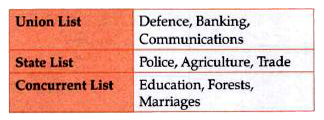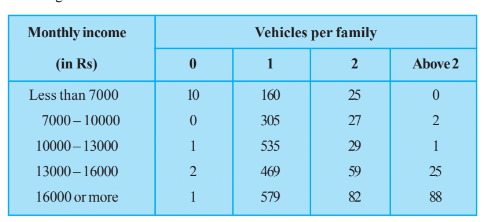A few subjects in various Lists of the Indian Constitution are given here. Group them under the Union, State and Concurrent Lists as provided in the table below.
A.Defence,B.Police, C. Agriculture,D. Education, E. Banking, E Forests, G. Communications, H. Trade, I. Marriages


Detailed Answer:
Union list includes the subjects of national importance.
State list contains the subjects of state and local importance.
The concurrent list includes the subjects of common interests to both the Union Government as well as the State Governments.
Similar Questions
In given question consists of a statement followed by two arguments I and II. Give answer (a) if only argument I is strong,(b) if only argument II is strong, (c) if either I or II is strong, (d) if neither I nor II is strong and (e) if both I and II are strong.
Statement: Should 'education' be brought under the control of the Central Government like defence?
Arguments: I No. Education is a state subject and it should remain with the state.
II. Yes. This is the only way to establish uniformity in growth of education across the states.
View SolutionFor given question, a statement is followed by two conclusions. Point out the correct conclusion:
(a) If only conclusion I is true
(b) If only conclusion II is true
(c) If both the conclusions are true
(d) If neither of the conclusion is true
Statement: Education is in the concurrent list. The State Government cannot bring reforms in education without the consent of the Central Government.
Conclusions:
I. For bringing about quick reforms in education, it should be in the state list.
Il. States are not willing to bring about quick reforms in education.
View Solution
Knowledge Check
Which among the following comes under Union List of Indian Constitution?
I. Defence
II. Inter-sta te Trade and Commerce
III. BankingAOnly IBOnly IICBoth I and IIDAll, I II and IIIConsider the following statements and select the correct answer from the codes given below :
Assertion(A) : K.C. Wheare calls Indian Constitution a quasi-federal Constitution.
Reason (R) : There are three lists (Union, State and Concurrent) in the Seventh Schedule of the Constitution of India dividing powers between the Centre and the state and giving residuary powers to the central government.ABoth A and R are individually true and R is the correct explanation of ABBoth A and R are individually true but R is not the correct explanation of ACA is true but R is falseDA is false but R is trueAnalyse the imformation given below considering one of the following correct options :
It includes subjects of common interest to both the Union Government as well as the state Governments, such as education, forest, trade unions, marriage, adoption and succession . Both the Union as well as the State Governments can make laws on the subjects mentioned in this list .AConcurrent ListBUnion ListCState ListDGovernment List
An organization selected 2400 families at random and surveyed them to determine a relationship between income level and the number of vehicles in a family. The information gathered is listed in the table below:

Suppose a family is chosen. Find the probability that the family chosen is (i) earning Rs 10000 – 13000 per month and owning exactly 2 vehicles. (ii) earning Rs 16000 or more per month and owning exactly 1 vehicle. (iii) earning less than Rs 7000 per month and does not own any vehicle. (iv) earning Rs 13000 – 16000 per month and owning more than 2 vehicles. (v) owning not more than 1 vehicle
View SolutionIdentify the labelled iterms A,B,C,D,E,F and G in the diagrame below from the list-I to VII given with

View SolutionThe table given below lists the bound dissociation energy (Ediss) for single covalent bonds formed between C and atom A,B,D,E.
What of the atoms has smallest size?
View SolutionIn each of the following questions ,arrange the given words in a meanningful sequence and then choose the most appropriate sequence from amongst the alternatives provided below question.
(a)Child (b)Job
(c )Marriage (d)Infant
(e )Education
View SolutionThe table given below lists the bound dissociation enegrgy (Ediss) for single covelent bonds formed between C and atom A,B,D,E.

What of the atoms has smallest size?
View Solution
